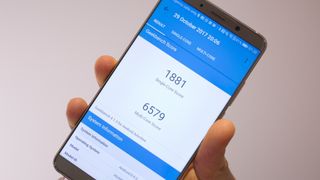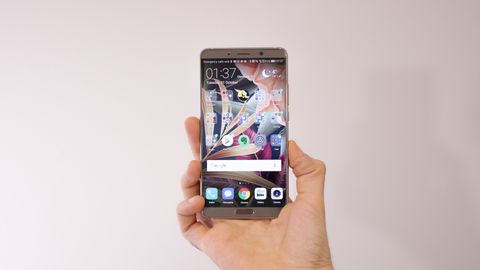Why you can trust TechRadar
Interface and reliability
- Feature-packed but cluttered interface
- Runs Android Oreo
- Includes a useful desktop mode
The Mate 10 launched with the latest version of Google’s Android, also known as Oreo. This puts it at an advantage from the start over much of the competition.
On top of giving it access to all the apps in the Google Play Store, Oreo offers support for features like picture-in-picture video at an operating system level, not to mention the latest security updates.
Not content with Google’s UI, Huawei supplements the experience with its own Android Skin, EMUI 8.
Amongst the most customizable of mainstream smartphone interfaces, it gives you control over everything from home screen transitions, icon themes and screen color calibration through to navigation bar layout, knuckle input and fingerprint gestures.

If all that sounds like overkill, it’s because Huawei has been layering EMUI with quirky features for generations, with EMUI 8 being a culmination to date.
The newest addition to the interface, introduced on the Mate 10 series, is EMUI desktop. This is similar to Samsung’s DeX interface on the Galaxy S8 range and Note 8. The key difference with EMUI desktop is that it doesn’t require a pricey dock to activate the experience, just an inexpensive USB-C to HDMI cable.
The reality is unsurprisingly less refined than DeX. Third-party app compatibility and window resizing isn’t as capable, and native app support is more limited.

If we think back to DeX when it launched at the beginning of the year though, it was significantly worse than it is now. So while EMUI Desktop isn’t a reason enough to pick up the Mate 10 just yet, with continued support and necessary improvements from Huawei, it could offer some serious added value in the coming months.
As it stands though, the Mate 10 and EMIU are a capable combination, but are at times overbearing. If you want a simple UI, iOS and Google’s stock Android as found on the Google Pixel 2 and Pixel 2 XL feel less cluttered.
On the other hand, if you want to tinker, EMUI and the Huawei Mate 10 could be the perfect interface and device combination for you.
Movies, music and gaming
- HDR10 support means videos can look great
- Good speakers
- Plenty of power for gaming
The screen on the Huawei Mate 10 may look a little bit lackluster when held up alongside OLED displays like those found on the Note 8 and Huawei Mate 10 Pro, but in isolation, it’s good. In fact, it’s better than good – it’s great.
The Mate 10’s HDR10 tech means if you’re watching HDR content, whether it’s streaming from Amazon Prime Video or Netflix, or pre-loaded on the ample 64GB of storage or on a microSD card, it beats out most LCDs around.

Watching standard content also looks decent, with accurate colour reproduction and cracking brightness levels, making outdoor viewing better than on most phones. The only area it falls down is when you’re looking for masses of vibrancy and contrast across videos and games. In those instances it’s a touch washed out.
Still, gaming is a treat on here thanks to the powerful Kirin 970 chipset combining with the generous screen and stereo speakers.
While you have the option to plug headphones in using the 3.5mm port, you won’t need to, with sound produced from the bottom and front-firing speakers faring better than on mono speaker rivals like the OnePlus 5.
Volume is plentiful and it doesn’t get too tinny at the top-end, making it one of the best smartphone speakers around right now, roughly on par with the iPhone 8 Plus and just marginally worse than the Pixel 2 XL.
Performance and benchmarks
- Lots of power
- Competitive benchmark scores
Huawei talked a lot about AI when introducing the Kirin 970 to the world at IFA 2017, though it isn’t this mysterious AI implementation that makes the chipset inside the Mate 10 great a week into use – it’s its sheer horsepower.
Paired with 4GB of RAM, the octa-core Kirin 970 and Mate 10 fly through split-screen multi-tasking and high-performance gaming, as well as all the standard UI requests expected from a phone a week into use.

Benchmarks are fittingly high, with Geekbench scores ranging from 6039-6630, among the highest of a device of the Mate 10’s price.
Between the numbers and real-world use, everything suggests that you are relatively future-proofed from a performance standpoint should you pick up the Mate 10.
Huawei even goes a step further, promising that the Mate 10 won’t slow down after 18-months, owing to machine learning. We can’t confirm or deny this claim, but an intensive week into use, so far so good.
Current page: Anything else I should know?
Prev Page Battery life and camera Next Page Verdict and competitionBasil Kronfli is the Head of content at Make Honey and freelance technology journalist. He is an experienced writer and producer and is skilled in video production, and runs the technology YouTube channel TechEdit.


